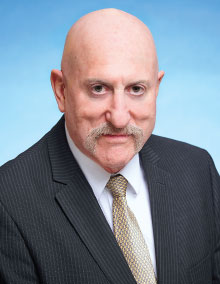It’s All About the Beds: Geller to Focus on Inpatient Bed Shortage as Discrimination
Abstract
The new APA president said the crisis in public mental health—most glaring in the shortage of inpatient beds—should be regarded as a form of discrimination and prejudice.

APA President Jeffrey Geller, M.D., M.P.H., says that APA’s most significant progress in the 21st century is the diversity of the membership.
At the heart of the mental health crisis in the United States is the dramatic shortfall of inpatient psychiatric beds, according to incoming APA President Jeffrey Geller, M.D., M.P.H.
In his address at the Opening Session of the virtual APA Spring Highlights Meeting in late April, Geller spoke of the interrelated problems in the nation’s public mental health system that predated the global COVID-19 pandemic and will remain in its aftermath: health inequities, social marginalization of people with serious mental illness, and inadequate resources to treat psychiatric patients.
He recounted the dismal realities of America’s public mental health in the 21st century:
At least 20% of inmates in jails and prisons have a serious mental illness.
People with untreated serious mental illness make up one-third of the total homeless population in the United States.
Suicide rates in the United States increased by 33% between 1999 and 2017, with an increase in some states as high as 59%.
Between 2000 and 2017, unintentional deaths and suicides related to opioid use increased substantially. From 2012 through 2018, the rate of drug overdose deaths involving cocaine more than tripled, and the rate of deaths involving psychostimulants with abuse potential (such as methamphetamine) increased nearly fivefold.
But Geller said addressing the psychiatric bed shortage is key. “Fundamental to extricating ourselves from the current quagmire of services for persons with mental illness is getting to the right number of psychiatric beds,” he said. “Too few, and we have the conditions I’ve described; too many, and we pull resources away unnecessarily from alternatives to hospitalization.”
In addition, Geller said that psychiatry and the mental health community need to move past “stigma” as a talking point to a discussion of prejudice and discrimination. “Discrimination against those with serious mental illness is no different from prejudice against other groups deprived of equal opportunity due to their genetics, infections, or accidents,” he said.
“But we cannot focus only on what we have yet to do,” Geller said. “The spring of 2020 has seen more than its share of despair. Where are we succeeding?” Among the strides in psychiatry that Geller cited were these:
Telepsychiatry, blossoming even before COVID-19, is quickly becoming commonplace.
Enhanced understanding of the impairments that render patients with serious mental illness unable to acknowledge their own illness are lending support to the judicious use of involuntary treatment in inpatient and outpatient settings.
Significant strides are being made in assisting people with serious mental illness to become employed, particularly through clubhouses.
The success of long-acting injectable medications is helping to “make a significant dent in the prevalence of nonadherence to psychiatric medications.”
Innovative integrated care strategies are extending psychiatric expertise to more people in need.
Advocacy is steadily chipping away at the arcane institutions for mental disease (IMD) exclusion, a requirement that excludes most Medicaid beneficiaries with mental illness from coverage in psychiatric hospitals.
Regulatory changes are allowing expansion of the number of buprenorphine prescribers, and Narcan is being made more widely available for emergency treatment of overdoses.”
Geller said the most significant progress in the 21st century is the diversity of the body that is the APA membership. “Just think how different we are from our predecessors,” he said. In 1890 APA had 175 members, 139 of whom were still living (at that time, members did not lose membership status upon death). All were Caucasian men, 90% had a beard and/or a mustache.
“Now APA is an organization of enviable heterogeneity,” Geller said. “And we shall continue to progress with more and more underrepresented group members having more and more of a presence in APA.”
Returning to the crisis that has upended life around the globe, Geller offered a tribute to psychiatrists everywhere doing their part to meet the challenge of COVID-19.
“In the APA Annual Meetings of 1918 and 1919, no mention of the raging influenza epidemic was made,” said Geller. “We shall not commit the same oversight. Together we thank our fellow psychiatrists who have been on the front lines every day and our trainees who have been pinch-hitting wherever they’ve been needed. And in quiet moments, each in our own way, we can remember our colleagues whose work with COVID patients ceased with the end of the doctor’s life.” ■



